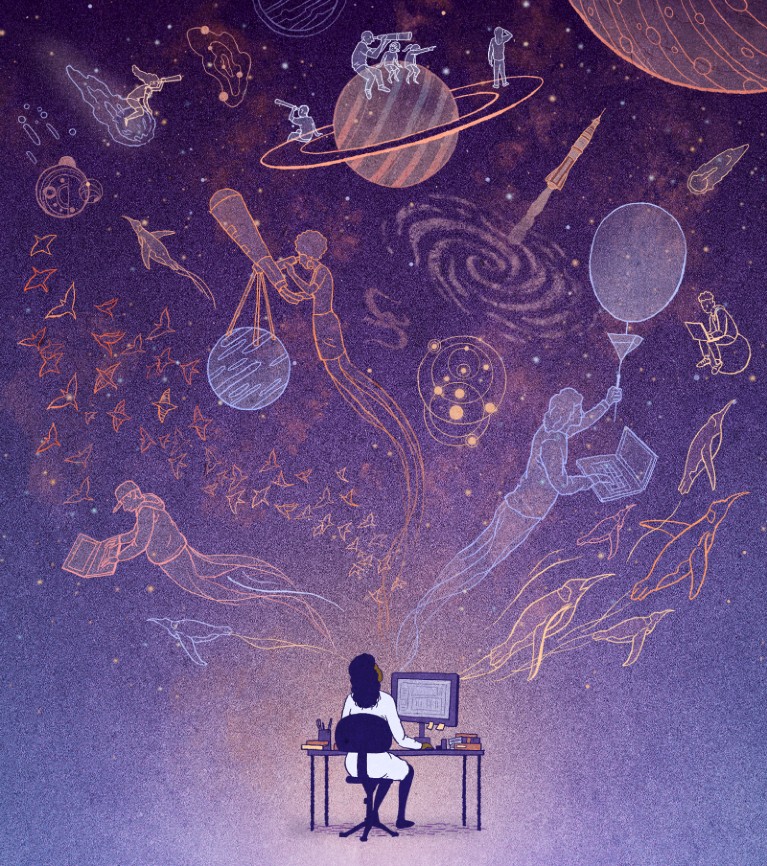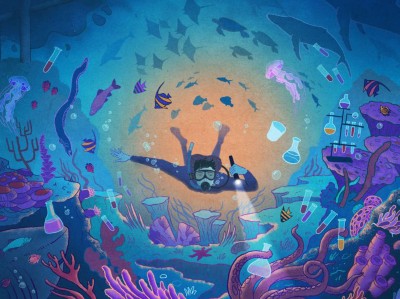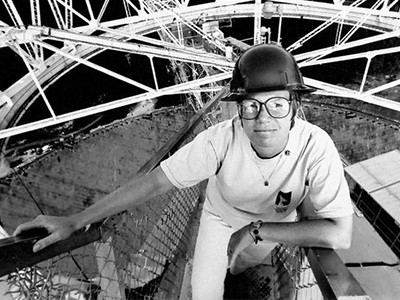
Illustration by Antoine Dore
The Crowd and the Cosmos: Adventures in the Zooniverse Chris Lintott Oxford University Press (2019)
Citizen science is booming. Today, anyone with a computer or a smartphone can participate in research in astronomy, oceanography, medicine, zoology and beyond. With such studies no longer the exclusive realm of an elite few, communities of amateur and professional scientists have joined together to democratize the discipline, harnessing mutual enthusiasm and collective wisdom to gather and analyse data.
Total immersion: re-imagining the ocean
As a research tool, crowdsourcing is nothing new. Charles Darwin maintained a voluminous correspondence with fellow naturalists and lay enthusiasts in the Victorian era. For more than a century, the US-based National Audubon Society has relied on an army of volunteers to count birds across North America each December. And since 1911, the American Association of Variable Star Observers in Cambridge, Massachusetts, has enlisted a network of predominantly amateur astronomers to collect nearly 40 million observations of stars that have fluctuating brightness. That endeavour has provided valuable insights into stellar lifecycles and distances to galaxies. SETI@home, launched in 1999, meanwhile uses the idle time on millions of home computers to search for radio signals from extraterrestrial civilizations.
In recent years we’ve seen an explosion in new opportunities, in fields such as cetology, linguistics and space archaeology. The SciStarter website, for example, currently aggregates thousands of citizen-science projects and events from around the world.
One researcher who has been at the forefront of the phenomenon for more than a decade is Chris Lintott, professor of astrophysics at the University of Oxford, UK, and a presenter of The Sky at Night, the BBC’s monthly astronomy television show. In his new book, The Crowd and the Cosmos, Lintott tells the story of the most ambitious, successful citizen-scientist initiative so far: Zooniverse, which boasts 1.6 million registered users. Through its platform, people can, in effect, become research assistants to scientists working on projects in a profusion of fields. What these have in common are large quantities of data and a need for human eyes, ears and brains to help make sense of them.
Zooniverse emerged from the success of Galaxy Zoo, Lintott’s first citizen-science venture. In 2007, faced with the daunting task of classifying millions of galaxies imaged by the Sloan Digital Sky Survey telescope in New Mexico, Lintott and colleagues solicited help through a brief slot on BBC Radio’s morning current-affairs programme. The response was beyond anyone’s wildest dreams. Within a few days, volunteers were classifying 70,000 galaxies every hour on their own computers.
One of Lintott’s key messages is that citizen science is much more than free labour. Many such projects exploit the human brain’s ability to recognize patterns, or to spot unusual features in data that even the most sophisticated computer algorithms can miss. Collaborations between professional and amateur researchers also increase public understanding of science, and have produced a growing list of publications in peer-reviewed journals. The first Galaxy Zoo paper, released in 2008, has been cited in more than 500 other astronomy papers (C. J. Lintott et al. Preprint at https://arxiv.org/abs/0804.4483; 2008). Reef Life Survey, a citizen-science project that engages recreational divers around the world to monitor biodiversity in coral reefs, has produced nearly 60 peer-reviewed papers so far, including 5 in this journal.
Citizen scientists have also made serendipitous discoveries on their own. In 2007, for example, Dutch school teacher Hanny van Arkel stumbled upon a mysterious green blob in an image she was examining for Galaxy Zoo. This unusual object, which became known as Hanny’s Voorwerp (Dutch for ‘Hanny’s thingy’), is now thought to be a giant cloud of gas illuminated by a powerful blast from a supermassive black hole in the neighbouring galaxy IC 2497.
Zooniverse, as Lintott shows, hugely expands the field of investigation. Penguin Watch, for example, invites volunteers to monitor the rise and fall of Antarctic penguin populations by counting birds photographed by a network of automated cameras. Snapshot Serengeti uses a similar approach to study animal ecosystems revealed by millions of photographs taken with motion-sensitive cameras throughout Tanzania’s Serengeti National Park. The Space Warps project invites armchair astronomers to search for rare but spectacular gravitational lenses, created when gravity distorts images of faraway galaxies. These act like enormous funhouse mirrors to produce optical illusions on the grandest scale.
Lintott is not the first to write about this topic. Caren Cooper’s 2016 Citizen Science, for example, was illuminating. However, it is hard to imagine anyone more qualified than Lintott — a veteran of the citizen-science trenches — to give an insightful perspective. And he does so both accessibly and engagingly. There is a flavour of Bill Bryson’s breezy erudition in A Short History of Nearly Everything (2003), although the book does ramble in places. Overall, however, Lintott deftly interweaves personal experience and more philosophical ruminations on public participation in science.
What of the future of citizen science? Astronomy, once photon-starved, will soon be awash in 15–30 terabytes of new data nightly from the Large Synoptic Survey Telescope in northern Chile, triggering myriad follow-up observations. Other fields face similar challenges coping with an ever-faster flow of data. Genomic researchers are both blessed and burdened by a deluge of data emanating from hugely accelerated sequencing. And remote-sensing observations by a growing armada of satellites, such as the joint European–Japanese EarthCARE mission scheduled for launch in 2021, will map and measure our planet’s surface as never before over the next decade. Although increasingly powerful computers and artificial intelligence can help to analyse the data tsunamis, they won’t make citizen scientists obsolete any time soon.
Scrutinizing Earth’s surface is one thing; having an impact on the future of the planet and its people is another. Can citizen science change the world? Maybe. From monitoring flower production by plants as a gauge of climate change to analysing brain scans in the quest to find the cause of Alzheimer’s disease, lay researchers are actively improving lives globally. Just days after Hurricane Dorian devastated the Bahamas in late August, a new Zooniverse project was already helping rescue efforts as volunteers identified damage visible in satellite images.
Moreover, as Lintott reminds us, this great public venture is helping to foster a more scientifically literate society, and empowering a new generation of scientists. Not bad for a free app that you can download to your phone.



 Hunting aliens
Hunting aliens
 Citizen medicine
Citizen medicine






